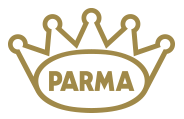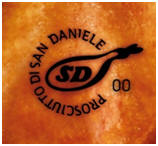The
variety
at
the
deli
counter
is
growing
with
more
and
more
choices,
but,
in
most
cases,
staff
are
not
terribly
knowledgeable
about
the
products
they
sell.
How
do
you
know
the
prosciutto
you
are
purchasing
is
authentic
Italian
prosciutto
rather
than
a
domestic
or
Canadian
brand?
Here
are
some
tips
and
tricks
to
ensure
you
are
getting
a
quality
product.
Like
cheese,
wine
and
pasta,
authentic
Italian
prosciutto
is
highly
regulated
in
order
to
ensure
the
quality
of
the
product
is
consistently
maintained.
However,
since
true
prosciutto
is
so
highly
regarded,
knock
off
versions
abound
throughout
the
world,
and,
due
to
USDA
regulations
on
cured
meats,
certain
imports
are
banned
entry
from
the
country.
Therefore,
American
companies
attempt
to
create
domestic
versions
of
these
popular
products
as
well.
Authentic
Italian
prosciutto
reflects
the
region
in
which
it
is
produced.
Each
variety
has
a
distinct
flavor
profile.
In
the
United
States,
the
two
most
commonly
sold
types
of
Italian
prosciutto
are
Prosciutto
di
Parma
and
Prosciutto
di
San
Daniele.
Prosciutto
di
Parma
is
produced
in a
specific
area
of
Parma,
Italy
from
a
specially
selected
breed
of
pigs
who
feed
on a
regulated
diet
that
includes
whey
from
the
Parmigiano
Reggiano
cheese
also
produced
in
this
zone.
Prosciutto
di
San
Daniele
is
produced
in
the
area
of
Udine,
located
in
the
far
north-east
area
of
Italy.
The
pigs
used
to
make
Prosciutto
di
San
Daniele
are
bred
and
raised
only
in
Italy
and,
likewise,
their
diet
is
highly
regulated.
Both
types
of
prosciutto
carry
the
“Protected
Designation
of
Origin”
(PDO/DOP)
seal.
Additionally,
there
are
consortiums
for
Parma
and
San
Daniele
prosciutto.
Producers
within
each
consortium
are
legally
bound
to
uphold
the
strict
quality
and
production
standards
required
to
make
this
renowned
product.
Products
that
adhere
to
these
standards
receive
the
mark
of
the
consortium
certifying
it
as
an
authentic
product.
When
you
are
shopping
for
authentic
Italian
prosciutto,
first
look
for
the
PDO/DOP
seal
on
the
prosciutto
packaging.
Next,
look
for
the
Prosciutto
di
Parma
or
Prosciutto
di
San
Daniele
stamp
branded
onto
the
prosciutto
itself
to
ensure
you
are
buying
the
real
thing.


Prosciutto
without
these
marks
indicate
a
potentially
inferior
product
and/or
one
that
is
not
necessarily
produced
in
Italy.
Finally,
Prosciutto
di
San
Daniele
is
readily
identifiable
by
the
trotter,
or
foot,
of
the
pig
that
remains
at
the
end
of
the
prosciutto.
While
available
at
high
end
meat
counters,
Prosciutto
di
San
Daniele
is
very
limited
in
production
and
will
likely
cost
more
than
Prosciutto
di
Parma.
However,
many
vendors
in
the
United
States
carry
a
product
called
“Prosciutto
San
Daniele.”
Unfortunately
it
is
not
the
same
as
the
Italian
version.
This
is a
brand
of
Canadian
prosciutto
that
is
often
mistaken
for
the
Italian
Prosciutto
di
San
Daniele
even
though
it
costs
much
less.
We
hope
the
next
time
you
are
at
the
deli
counter,
these
tips
will
help
you
make
the
best
choice
when
selecting
prosciutto.
Sources:
http://www.prosciuttodiparma.com/en_UK/home
http://www.prosciuttosandaniele.it/en/the-ham/san-daniele-ham



